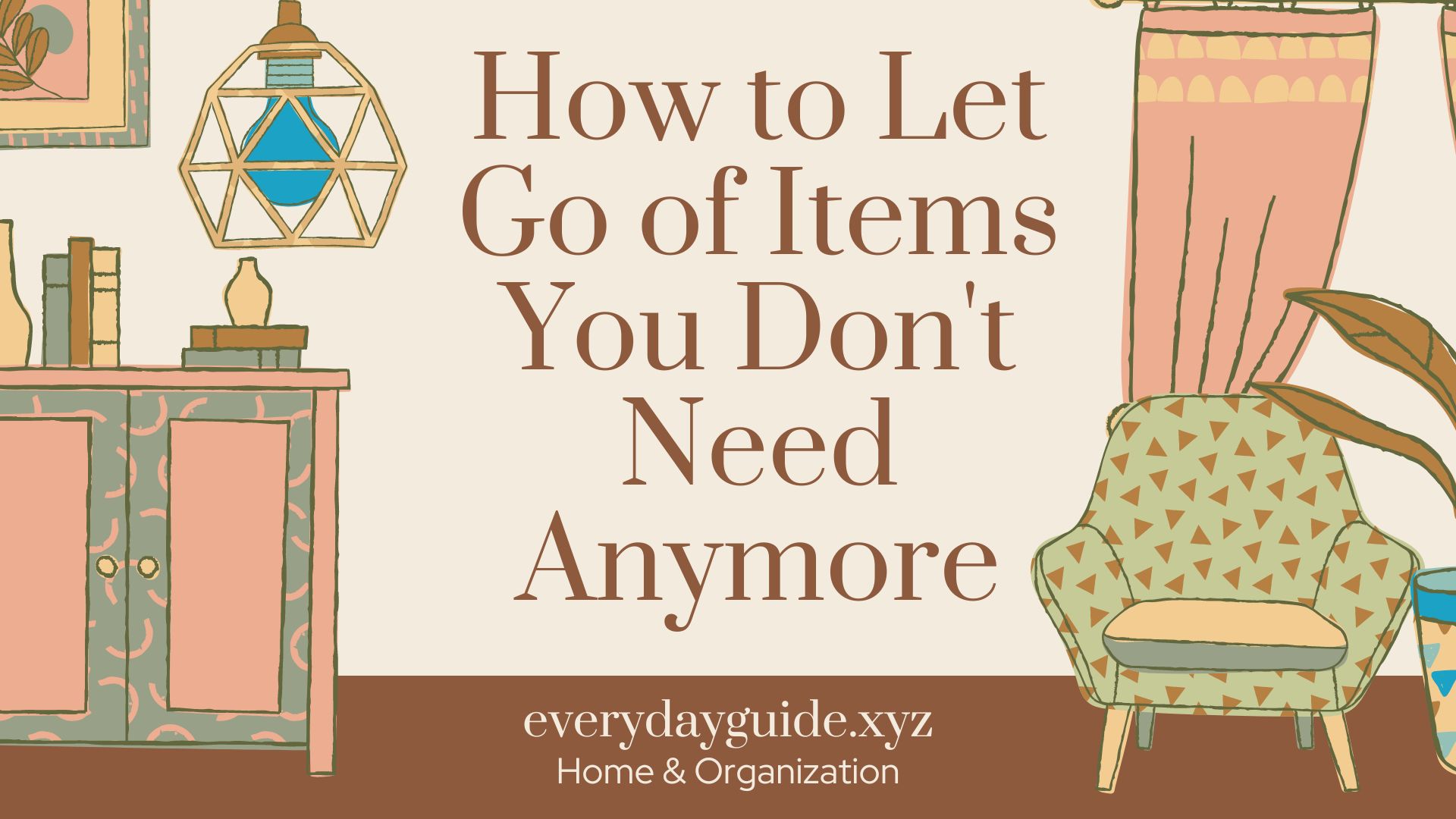It reached a point that it can emotionally and mentally exhausting to finally part with it. Sentimental value: a lot of us are hoarders, or we like buying stuff hoping one day we’ll use it. But, if you can learn to let go of things you no longer want or need then life will be organized and clutter free which also allows for a more peaceful life. This guide will cover a few useful tips and actionable steps that you can take in order to declutter your home and eliminate clutter from your life for good.
Why We Cling to Things
Understanding the reason why you can’t seem to part with things you will never use before we get started on the decluttering process. We are sentimental; we believe these material goods will come in useful one day. Obviously, if you keep it…you get clutter!!
Attachment to Things on the Emotional Level

Common Reasons People Have Trouble Letting Go Of Things Emotional Attachment “It was my first ___”. No matter it is a childhood relic or a gift from your treasured one, these things are synonymous with memories and emotions. But remember, memories are inside you not in things. Theres no problem holding onto a few items that mean something but too much stuff stops you from living in the now and having an organised life.
Future Item Needs or To-Use-Again-Some-Day Fears
A second reason why people hold on to things is due to the fear that they will need something someday. You may have clothing you no longer wear, kitchen gadgets that are newly purchased but never or rarely used, or old electronics you have traded in for a new model. But realistically, most of these are rare things to need. Getting rid of stuff that you do not actually need opens both doors in your house and between ears for completely new experiences and opportunities.
How to Decide What You Do Not Need To Keep
Clutter is so easy to ignore especially when you have been living with it forever. The first place to start is in discerning what you no longer require. But now the Sta.sh process goes like this.
- Ask Yourself Key Questions
- Ask yourself the following when going through your things
- The last time I used this what year?
- Do I already own something similar?
- If I had to purchase this sucker all over again today, would I?
Evaluating the answers to these questions can assist you in forming a more critical view on if an item should clear your life. One of the recommended guidelines: If you have not used it in one to six months, it is time to let it go.
Start with the Easy Stuff

Take this bit by bit and do an easy clean first if the idea of decluttering feels too much. If you can furnish the strength to sort through things that are not too significant sentimentally, such as old magazines, expired products in the pantry or perhaps worn-out clothing. The momentum that you pick up will make it considerably easier to do other things, such as getting rid of sentimental items or gifts.
Create a Sorting System
A clear sorting system is essential, it speeds up the decluttering process. Create three categories:
- Keep
- Donate
- Throw Away
While you are doing that, sort your items from here into the three categories. Throw out or recycle broken, expired, or otherwise unusable items. If items still in good shape that no longer have a use for can be donated. And only keep what you really need or love.
5 Reasons Why You Need To Let Go Of Your Ex Boyfriend Or Girlfriend(s)
One of the most significant hurdles to declutter is the emotional connection we have with things. But, there are ways to help you work through this and make the process a little less painful.
Look at Why Clutter is Harmful
Think of the advantages of getting rid of unnecessary stuff A clutter-free space can elevate mood, increase productivity and make your home a more calming place to be. Not only do we remove what no longer serves us, making space for new experiences, ideas, and opportunities. You are concentrating on benefits instead of sacrifice, and the journey suddenly becomes much more interesting.
Keep Memories, Not Things
Memories are in your head, not on things Try this instead: If you are attached physically to an item (i.e. box of concert tickets, old clothes that don’t fit in your current lifestyle anymore or childhood toys) — take a photo of it and leave the actual listed above behind. So as to hold onto the memory, but let go of the object. You may even set up a memory box with a few small mementos from nostalgic times to recognize your past, but to not let the clutter take over your space.
Let Go of the Guilt

We have that little voice in the back of our head saying throw it away, — but you feel guilty about throwing a gift or something you spent money on and never used. The shame in this is something that we need to get rid of. The value you place in an item is not counted in the mere weight it occupies, rather on how much joy or use it will bring you. Fulfillment should be your responsibilityIf an object isn’t making you happy then just rid of it. This can give you a sense of solace and relief because someone else may need it — make use out of it.
Also Read More:
- Easy Packing Hacks to Save Space in Your Suitcase
 How to Fit Unbelievable Amounts of Technical Offroad and Overland Gear into your Bags Maximize the space in your bag, to minimalize the stress of packing for a trip How to pack effectively, save space and not even get clothes wrinkled… Read more: Easy Packing Hacks to Save Space in Your Suitcase
How to Fit Unbelievable Amounts of Technical Offroad and Overland Gear into your Bags Maximize the space in your bag, to minimalize the stress of packing for a trip How to pack effectively, save space and not even get clothes wrinkled… Read more: Easy Packing Hacks to Save Space in Your Suitcase - How to Pack a Carry-On Like a Pro in 5 Simple Steps
 It has been a complete game-changer to pack less and go the carry-on route. It saves you time at the airport, and it also simplifies any trip to your destination. Have you ever wanted to learn how to pack a carry… Read more: How to Pack a Carry-On Like a Pro in 5 Simple Steps
It has been a complete game-changer to pack less and go the carry-on route. It saves you time at the airport, and it also simplifies any trip to your destination. Have you ever wanted to learn how to pack a carry… Read more: How to Pack a Carry-On Like a Pro in 5 Simple Steps - How to Keep Your Clothes Wrinkle-Free While Traveling
 As thrilling as traveling can be, the reality is that removing wrinkles from clothing while on the move remains among the popular problems travelers encounter. There is nothing worse than setting out for a busy day in a new city or… Read more: How to Keep Your Clothes Wrinkle-Free While Traveling
As thrilling as traveling can be, the reality is that removing wrinkles from clothing while on the move remains among the popular problems travelers encounter. There is nothing worse than setting out for a busy day in a new city or… Read more: How to Keep Your Clothes Wrinkle-Free While Traveling - How to Travel Cheap Without Sacrificing Fun
 One of the most enriching experiences in life happens to be traveling, but it always seems as though travel comes at a steep price. But it is possible to travel and have fun on a tight budget with some creativity and… Read more: How to Travel Cheap Without Sacrificing Fun
One of the most enriching experiences in life happens to be traveling, but it always seems as though travel comes at a steep price. But it is possible to travel and have fun on a tight budget with some creativity and… Read more: How to Travel Cheap Without Sacrificing Fun - Best Apps for Finding Cheap Flights and Hotels
 Everyone loves to travel but the sky-rocketing prices of flights can sometimes drive us to halt our wanderlust. But, fortunately in today ‘s age of fast technology this is not so tough to discover your Cheap Flights In London as well… Read more: Best Apps for Finding Cheap Flights and Hotels
Everyone loves to travel but the sky-rocketing prices of flights can sometimes drive us to halt our wanderlust. But, fortunately in today ‘s age of fast technology this is not so tough to discover your Cheap Flights In London as well… Read more: Best Apps for Finding Cheap Flights and Hotels
Smart Advice That Will Really Help You Let Go of Things You Need to Purge
When you are ready, the time to act will come. Below are some practical ways you can declutter all things that you do not need and living in a chaos world.
Set Decluttering Goals
Don’t attempt to declutter your entire home in one day, set achievable goals. Be especially focused with one area at a time, whether it be your closet, kitchen or garage. Take steps or tasks to achieve the same, then cheer else for completing a task. Create deadlines for each area and ensure to adhere with the dates in order to help you motivated.
Follow the William Morris [“One in, one out”] mantra
Use the ‘one in, one out’ rule.fetchall.. If you buy 1 new digidog, throw or give away an existing item. This helps maintain all your belongings smoothly and prevents the cluttering of things without a reason. So for example, when you buy new shoes then eliminate or recycle an old pair.
Use the 90/90 Rule
One decluttering method that is widely known is the 90/90 rule. If you have something you haven’t used in 90 days and won’t in the next 90 days, it’s time to trash it. It is a perfect way to choose andphans you have been wishy washy of forever, which defines eliminated stuff that just no longer serves it purpose, fitting into your life currently.
Caring for Memorabilia
Sentimental objects frequently have strong emotional attachment, which makes them amongst the most difficult objects to release. But, with that said, at a certain point holding onto sentiment is just keeping stuff for the sake of frikkin’ nostalgia which only creates clutter and keeps you in the past. How To Declutter that “In Between” Stuff
Retain the Top 20, Demote the Bottom 80

Instead of keeping every single object that holds a memory for you hang on to the ones that truly matter. Pick a handful of things that truly remind you of good times and accomplishments. However, she also shows that the rest of those items can go — you should arrange them nicely in a place like some sort of museum exhibit. Keeping everything is not necessary to keep the memory alive.
Consider Passing Items On
If you have some sentimental items that are in good condition, and that hold a strong memory for you say the best thing to do if possible is hand them on to family members who would want them. Give away heirloom you no longer use, for example. That way the item can move on to wherever it is supposed to go, without coming into your house.
Create a Digital Archive
If possible, digitize collections of old letters, photographs or children’s artwork. Then scan these items and keep them in your computer or cloud storage. The purpose is to save the memories that do not take up physical space. They are also easy to organize digitally in case you want to go through them later on.
What to do with unwanted stuff
Once you identify which things you are willing to part with then it is time for step #2 what to do with those items. From there, it is not just trash or no trash.
Donate to Charity
Items in decent shape make great donations for local charities, thrift stores or shelters. Clothing, furniture, household items, and electronics are lightening fast commodities in the thrift and resell market. Donating also allows you to help those in need, and it can provide peace of mind that your items will be put to good use.
As another option, host a yard sale.
If you own items that are in good condition and valuable, you might be able to sell them and earn some money on websites such as eBay, Craiglist or even Facebook Market. You could also simply have a garage sale — it really depends on how much stuff you are trying to offload. If it is, consider selling unwanted items for extra cash and more space.
Recycle or Repurpose
If things can’t be donated or sold, look at recycling and/or reusing. You can recycle electronics, old appliances and even clothing at specific centers. You can also recycle and think outside the box about how you repurpose items — have an old piece of furniture that no longer works, use it as a new decoration; have some old t-shirts that are just taking up space in your closet, cut them up for cleaning rags.
Conclusion
Parting with stuff is a liberating practice for freeing up both your physical and mental space. It is not a matter of going to extremes with what you own; simply create an environment that mirrors the way you would like to feel through your things. With these tips put into place you can declutter your home and life, release some possessions that are not serving you any more so that new experiences and memories can help flood back in.
And realizing you have the ability to part with material possessions that are no longer of any use will set you on the path toward a more simplified, more purposeful journey.

